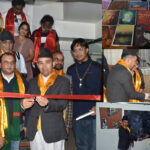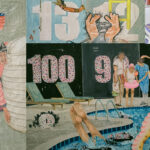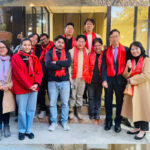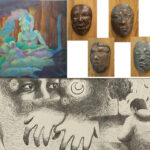“Back then, the life was not easy in Germany. The system of education was poor and the families were not economically sound. I was born in 1943 as a second child from my mother but her relationship with the father did not last long. My mother married again and I yet got four more siblings. Studying there, was not that easy as I grew up. I studied architecture (Werkkentschule) in Krefeld from 1963 to 1967,” recalls Wolfgang Korn about his early days.

In those days the use of modern technology was rare. The height, distance and area were measured using a folding scales.
In those days, it was mandatory to join the army for two years but he didn’t want to join it. In order to not to join the army, he made plan to visit other countries in order to serve as a volunteer. In those days, he had just read about West Africa in a novel and the other choice was Nepal of which he didn’t know anything except Edmund Hilary who had succeeded in climbing the Mt.Everest and he was not ‘Sir’ by then. His first- hand experience of Asia was India as he had a transit there. He stayed in Hotel Ashoka in order to get connecting flight to Nepal.

After he landed in Nepal for the first time in 1968, he was received by a group of German Volunteers at the Tribhuvan International airport and was led to Lazimpat. From there, in that very evening, he went to visit the Kathmandu Durbar Square. The smells, the sounds, the butter-lamps burning in some houses, the carvings of gods and goddesses in woods and stones made him mystified about the place.
He started traveling to different places in Kathmandu and made Architectural drawings of the monuments of the places and especially of Kathmandu Durbar Square. Some of the monuments were not accessible in those days. He vividly recalls one of the temples located just in-front of the Kasthamandap which got massively demolished during earthquake of 2015, which served as a temple for public and residential place for family who were living there. He had to give them few rupees in order to let himself in. Inside that temple, there was an access to go up but nobody had dared. He went upstairs and it was slippery and it was covered by pigeon shit and dust from last four centuries. He used his measuring tape and calculated the distance of each and every corner of that temple. It was his curiosity that led him there. The architecture of that place were really of different level. Local materials were used in such a way that even the nails were made of woods. “Had I fallen from there and lost my life during that time, my skeletons would have been recovered only after the earthquake,” Wolfgang brings smiles in his old face and recalls the moment. After the work was done, he handed those document to KVPC.(Kathmandu valley developmental plan)

“It is a pity that the reconstruction has been done in the Durbar Square using my blue-prints but my name is not mentioned anywhere,” says Mr. Korn. “While reconstructing the area, it has only been concretized using the modern technology. Nepalese style of architecture is unique in many ways, had they studied it more minutely, 80 percent of the materials could have been re-used. The metropolitan city has dumped all the soil of that area at Tundikhel without seeing what was inside it. From the architectural point of view, this should not have happened and Nepal lost a lot due to not managing the existing things,” he says.
In those days, he used to ride cycle to short destination and jeep to go to long distance. There were no motorbikes in those days. The roads used to be vacant and there would be a halt of traffic for half an hour if the king was travelling anywhere. “I had become clever by then, I used to make short-cuts if such incidents occurred,” laughs Wolfgang.

In the year 1968, when he started working for the ‘Design Section’ of the Department of Housing and Physical Planning of His Majesty’s Government of Nepal, there was no facility in his office for a long toilet. He had to rush back to Lazimpat at his lodging if such requirement happened. There were no restaurants in those days and people did not eat outside. “In the beginning for the first 3-4 days, I survived only with Jeri-Swari (Nepali popular sweets),” recalls Mr. Korn.
While staying in Nepal, he was also involved in various forms of sports. After living in the Lazimpat area for some time, he moved to New-road. From time to time, when he had free time or was monotonous, he used to go to Tundikhel and play football.
Rajan Shakya, the director of Museum of Nepali Arts (MONA) feels that the contribution Mr. Korn made while he was in Nepal back then needs to be celebrated by all. There are so many Bahas (a group of temples ) and monuments that need to be researched and their architectural design needs to be studied. ‘The old name of Kathmandu was Kasthamandap which was derived from a temple. Thanks to Mr. Korn’s blueprints that the structure of Kasthamandap which also stands as a pride for Kathmandu got resurrected,’ says Mr. Shakya.

From March 10 to 20, at the Musuem of Nepali Arts (MONA) the exhibition of the architectural as well as other drawings of Mr. Korn is put on. Mr. Shakya, the director of MONA says that the visitors could access the MONA for free in order to see the works of Mr. Korn. “Museums usually do not sell the art works, but this time, in order to help Mr. Korn write his biography, we are also selling some of his art-works,” says Mr. Shakya.







Leave A Comment